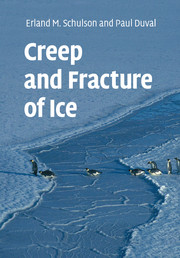Book contents
- Frontmatter
- Contents
- Preface
- Acknowledgements
- 1 Introduction
- 2 Structure of ice
- 3 Microstructure of natural ice features
- 4 Physical properties: elasticity, friction and diffusivity
- 5 Plastic deformation of the ice single crystal
- 6 Ductile behavior of polycrystalline ice: experimental data and physical processes
- 7 Modeling the ductile behavior of isotropic and anisotropic polycrystalline ice
- 8 Rheology of high-pressure and planetary ices
- 9 Fracture toughness of ice
- 10 Brittle failure of ice under tension
- 11 Brittle compressive failure of unconfined ice
- 12 Brittle compressive failure of confined ice
- 13 Ductile-to-brittle transition under compression
- 14 Indentation fracture and ice forces on structures
- 15 Fracture of the ice cover on the Arctic Ocean
- Index
- References
1 - Introduction
Published online by Cambridge University Press: 01 February 2010
- Frontmatter
- Contents
- Preface
- Acknowledgements
- 1 Introduction
- 2 Structure of ice
- 3 Microstructure of natural ice features
- 4 Physical properties: elasticity, friction and diffusivity
- 5 Plastic deformation of the ice single crystal
- 6 Ductile behavior of polycrystalline ice: experimental data and physical processes
- 7 Modeling the ductile behavior of isotropic and anisotropic polycrystalline ice
- 8 Rheology of high-pressure and planetary ices
- 9 Fracture toughness of ice
- 10 Brittle failure of ice under tension
- 11 Brittle compressive failure of unconfined ice
- 12 Brittle compressive failure of confined ice
- 13 Ductile-to-brittle transition under compression
- 14 Indentation fracture and ice forces on structures
- 15 Fracture of the ice cover on the Arctic Ocean
- Index
- References
Summary
Creep and fracture of ice are significant phenomena with applications in climatology, glaciology, planetology, engineering and materials science. For instance, the flow of glaciers and polar ice sheets is relevant to the global climate system and to the prediction of sea-level change. The ice stored within the Greenland and the Antarctic ice sheets, should it flow into the sea, would raise the level by ∼7 m and ∼60 m, respectively. The creep of ice sheets, which can impart strains that exceed unity in several thousands of years, is also relevant to paleoclimatology. The determination of the age of ice and the age of greenhouse gases (Chapters 2, 3) entrapped within deep ice cores depends in part upon constitutive laws (Chapters 5, 6) that describe the deformation of the bodies – laws that must incorporate plastic anisotropy (Chapters 5 and 7) and the presence of water near the bottom. Fracture, too, plays a role in ice sheet mechanics. When the bed steepens, the ice flows more rapidly and creep can no longer accommodate the deformation (Chapters 9, 10). Fracture ensues, leading to the formation of glacier icefalls and crevasses. Fracture is of paramount importance in the catastrophic failure of icefalls, and it is a key step in the calving of icebergs and thus in the equilibrium between accumulation and loss of mass from polar ice sheets.
- Type
- Chapter
- Information
- Creep and Fracture of Ice , pp. 1 - 4Publisher: Cambridge University PressPrint publication year: 2009



